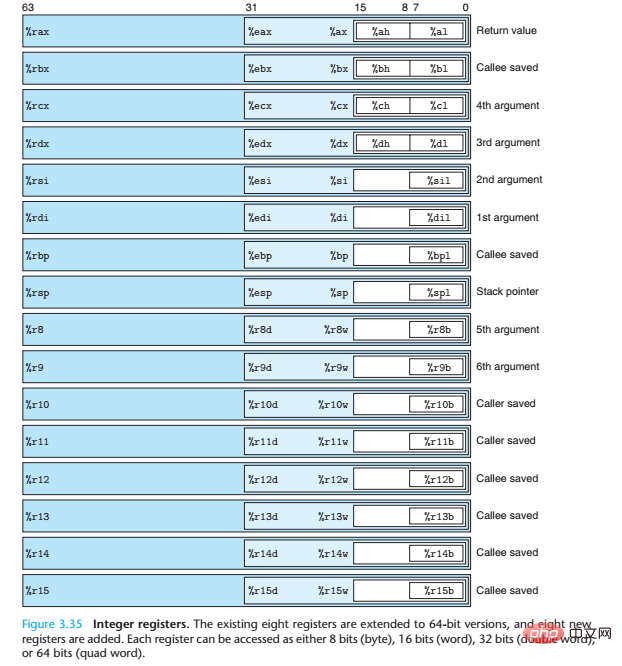
Differences: 1. Different register allocation, x64 has 16 registers, x86 only has 8 registers; 2. Different assembly instructions; 3. Different function calls; 4. Different parameter passing; 5. Different stack frames, x64 does not have a stack frame pointer, while x86 uses ebp as the stack frame pointer; 6. The computing speed of x64 is higher than that of x86.

#The operating environment of this tutorial: linux5.9.8 system, Dell G3 computer.
##0x01: Difference in register allocation

(2) 32 bits Use the stack frame as the storage location of the passed parameters, and use 64-bit registers, using rdi, rsi, rdx, rcx, r8, r9 as the 1-6 parameters respectively, and rax as the return value;
(3) 64-bit does not have a stack frame pointer, 32-bit uses ebp as the stack frame pointer, 64-bit cancels this setting, and rbp is used as a general register;
(4) 64-bit supports some forms of PC-related addressing, The 32-bit addressing method is only used when using jmp;
0x02: (New) Differences in assembly instructions

Supplement:
(1) movabsq is not a 32-bit extension, it is a purely new instruction. Used to store a 64-bit literal value directly into a 64-bit register. Because movq can only store 32-bit values, a new instruction
(2) 64-bit assembly code may add a rep before ret, here Rep has no practical meaning. It is just for the reason of AMD processor to avoid that the place where jmp reaches is directly ret, which will make the processor run faster
0x03: Differences in function calls
(1) x_64 parameters are passed through registers (see above);callq stores an 8-bit return address on the stack;
(2 ) Many functions no longer have stack frames. Only those that cannot place all local variables in registers will allocate space on the stack;
(3) Functions can obtain up to 128 bytes of stack space. In this way, the function can store information on the stack without changing the stack pointer (that is, the 128-byte space below rsp can be used in advance. This space is called the red zone. In x86-64, it is available at all times. );
(4) There is no longer a stack frame pointer, and the stack position is now related to the stack pointer. Most functions allocate all required stack space at the beginning of the call, and then keep the stack pointer unchanged;
(5) Some registers are designed to be callee-storage registers, and these must be changed when their values need to be changed. Store them now and restore them later.
0x04: Different parameters passed
(1) 6 registers are used to pass parameters (see above); (2) The remaining registers are passed as before (but they are related to rsp, ebp is no longer used as the stack frame pointer, and the 7th parameter starts from rsp, the 8th parameter starts from rsp 8, and so on); (3) When called, rsp moves down 8 bits (stored in the return address). The register parameters have no effect. The 7th and subsequent parameters are now the 7th starting from rsp 8, rsp 16 Start with the 8th one, and so on;0x05: Differences in stack frames
In many cases, stack frames are no longer needed, such as No other functions are called, and the register is enough to store the parameters, then only the return address needs to be stored. Situations that require stack frames:
(2) Some local variables are arrays or structures;
(3) Functions used The address operator is used to calculate the address of a local variable;
(4) The function must use the stack to transfer some parameters to another function;
(5) The function needs to save the state of some registers stored by the callee ( to facilitate recovery);
0x06: Different operating speeds
The data width of 64-bit CPU is 64 bits, and the 64-bit instruction set can run 64-bit data instructions, that is to say The processor can extract 64-bit data at a time, which is twice as high as 32-bit. In theory, the performance will be doubled accordingly.
Related recommendations: "Linux Video Tutorial"
The above is the detailed content of What is the difference between x64 and x86 in linux. For more information, please follow other related articles on the PHP Chinese website!